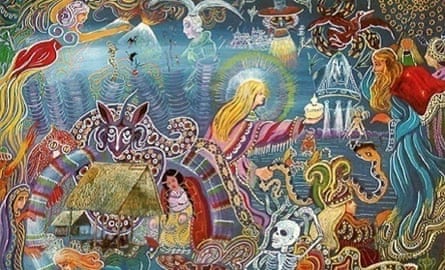
"In a hut, in a forest, in the mountains of Colombia, I am puking into a bucket. I close my eyes and every time my body convulses I see ripples in a lattice of multi-coloured hexagons that flows out to the edges of the universe." Vaughan Bell's description seems to be typical of the ayahuasca experience – at once unpleasant, frightening and enlightening.
Ayahuasca – meaning 'spirit vine' in Native South American Quechua languages – is a foul-tasting hallucinogenic brew that has been used for centuries by rain forest shamans as a religious sacrament. The infusion facilitates mystical visions and revelations, and is said to have healing properties. To date, there have been very few studies of how it affects brain function. Now, though, a team of Brazilian researchers reports one of the very first functional neuroimaging studies of the drug's effects.
The ayahuasca brew is made from the jungle vine Banisteriopsis caapi, which contains several beta-carboline compounds, and Psychotria viridis, a shrub containing the psychotropic dimethyltryptamine (DMT), which acts on specific subtypes of serotonin receptors. Taken on their own, neither of these ingredients has any significant effect, but when consumed together, they synergize.
Beta carbolines are potent inhibitors of the enzyme monoamine oxidase, which not only prevent breakdown of DMT, enabling it to exert its psychotropic effect, but also contribute to the drug's effects by elevating serotonin levels at synapses. The combined effect is a trip lasting up to 4 hours, characterized by vivid hallucinations.
Draulio de Araujo of the Brain Institute at the Federal University of Rio Grande do Norte recruited ten frequent ayahuasca users, and scanned their brains while they looked at natural photographs, imagined them with their eyes closed, and viewed scrambled versions of the photos. Afterwards, the participants drank ayahuasca-infused tea and, once the effects of the drug had kicked in, repeated the same tasks while their brains were scanned again.
The researchers then compared the brain activity patterns from the scans performed before and after ayahuasca intake. As expected, viewing the natural and scrambled photos activated the primary visual cortex in the occipital lobe at the back of the brain, and several other visual areas.
But these same areas were even more active when the participants closed their eyes and imagined the photos after taking ayahuasca. This is, however, not entirely surprising, as previous functional neuroimaging studies have shown that visual hallucinations are associated with abnormal visual cortical activity.
The scans also showed that the imagery task performed after ayahuasca intake was associated with increased activity in the parahippocampal gyrus, which is involved in retrieval of autobiographical memories and encoding of contextual knowledge, and the frontopolar prefrontal cortex, which is implicated in working memory and imaging future events. The researchers also observed altered connectivity between all these areas, and particularly in the relationship between the frontal and occipital cortices.
The study suggests that the visions induced by ayahuasca engage the brain's memory circuits, and that this may "feed" activity in the primary visual cortex, which in turn drives activity in the other visual areas. The observation that the primary visual cortex is more active during imagery with eyes closed than during viewing of actual images is in keeping with numerous reports of the vividness of ayahuasca visions. All of these effects are thought to be mediated by increased activation of serotonin receptors throughout the brain regions involved.
This is one of a small handful of neuroimaging studies looking at the neural basis of the ayahuasca experience. In recent years there has been renewed interest in the potential therapeutic benefits of psychedelics, and the new study contributes to our understanding of how this class of drugs affect brain function.
Reference:
de Araujo, D. B., et al. (2011). Seeing With the Eyes Shut: Neural Basis of Enhanced Imagery Following Ayahuasca Ingestion. Human Brain Mapping, DOI: 10.1002/hbm.21381
Comments (…)
Sign in or create your Guardian account to join the discussion